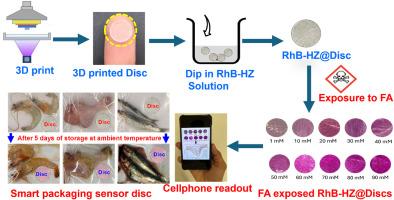基于罗丹明的化合物集成到3d打印结构中,用于选择性甲醛检测和食品腐败监测
IF 8.1
2区 环境科学与生态学
Q1 ENVIRONMENTAL SCIENCES
引用次数: 0
摘要
甲醛(FA)是一种应用广泛但毒性很大的挥发性有机化合物,对人体健康有重大危害,需要开发快速、灵敏、选择性强的检测平台。在这里,我们报告了一种新型比色传感器,该传感器将罗丹明基化合物(RhB-HZ)集成到3D打印结构中,用于FA的视觉和光学检测。合成了一种螺旋内酰胺结构的罗丹明衍生物,并将其嵌入光固化PEGDA/HEMA树脂中,从而可以使用数字光处理3D打印直接制造传感器圆盘和光学探头。暴露于FA后,探针发生选择性开环反应,产生鲜艳的粉红色,在562 nm处透射率降低,具有高特异性和对相关浓度和潜在干扰的线性响应。RhB-HZ对FA的检测下限(LOD)为0.0261 ppm,低于世界卫生组织(WHO)限值。此外,基于智能手机的读数通过传输激光的图像分析实现了便携式,经济高效的检测。这项工作首次展示了一种3d打印传感器,专门用于与食品腐败相关的痕量甲醛检测,这是该领域一种未经探索的方法。这些圆盘可以直观地显示密封包装中的鸡肉、沙丁鱼和对虾等肉类的新鲜度,为智能食品监控中的FA和其他分析物检测提供了可扩展、可定制和适应性强的平台。此外,使用RhB-HZ构建了比色抑制逻辑门,通过输入依赖的吸光度变化在562 nm处实现甲醛和硫化物的二元检测。本文章由计算机程序翻译,如有差异,请以英文原文为准。

Integration of rhodamine-based compounds into 3D-Printed structures for selective formaldehyde detection and food spoilage monitoring
Formaldehyde (FA) is a widely used yet highly toxic volatile organic compound that poses significant health hazards, necessitating the development of rapid, sensitive, and selective detection platforms. Here, we report a novel colorimetric sensor that integrates a rhodamine-based compound (RhB-HZ) into 3D printed structures for the visual and optical detection of FA. A spirolactam-structured rhodamine derivative was synthesized and embedded within a photocurable PEGDA/HEMA resin, allowing direct fabrication of sensor discs and optical probes using digital light processing 3D printing. Upon exposure to FA, the probe undergoes a selective ring-opening reaction, yielding a vivid pink color and reduced transmission at 562 nm, with high specificity and a linear response across relevant concentrations and potential interferents. The lower detection limit (LOD) of RhB-HZ for FA detection is 0.0261 ppm, below the World Health Organization (WHO) limits. Furthermore, smartphone-based readout enabled portable, cost-effective detection through image analysis of transmitted laser light. This work presents the first demonstration of a 3D-printed sensor specifically designed for trace-level formaldehyde detection related to food spoilage, an unexplored approach in the field. The discs visually indicate freshness in meats like chicken, sardines, and prawns inside sealed packages, offering a scalable, customizable, and adaptable platform for FA and other analyte detection in smart food monitoring. Further, a colorimetric INHIBIT logic gate was constructed using RhB-HZ, enabling binary detection of formaldehyde and sulfide through input-dependent absorbance changes at 562 nm.
求助全文
通过发布文献求助,成功后即可免费获取论文全文。
去求助
来源期刊

Chemosphere
环境科学-环境科学
CiteScore
15.80
自引率
8.00%
发文量
4975
审稿时长
3.4 months
期刊介绍:
Chemosphere, being an international multidisciplinary journal, is dedicated to publishing original communications and review articles on chemicals in the environment. The scope covers a wide range of topics, including the identification, quantification, behavior, fate, toxicology, treatment, and remediation of chemicals in the bio-, hydro-, litho-, and atmosphere, ensuring the broad dissemination of research in this field.
 求助内容:
求助内容: 应助结果提醒方式:
应助结果提醒方式:


